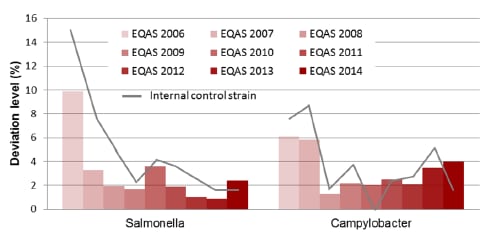The 17th proficiency test trial in 2014 was done by the National Food Institute (DTU Food) as the EU Reference Laboratory for Antimicrobial Resistance (EURL-AR).
It is the eighth External Quality Assurance System (EQAS) for these microorganisms.
The EQAS monitors the quality of AST results by National Reference Laboratories (NRL-AR).
Minimum Inhibitory Concentration (MIC) determination of Salmonella and Campylobacter test strains used the Sensititre system from Trek Diagnostic Systems.
Deviation level findings
The deviation level in 2014 was acceptable for both trials, said the EURL-AR.
For both microorganisms there was a slight increase in the level of deviations, to 2.4% for Salmonella and 4% for Campylobacter.
Thirty-three of 35 participating laboratories got a result within the acceptance limit at 5% deviations for the Salmonella strains.

For Campylobacter, the deviation can be explained by two laboratories’ high levels (34% and 22.9%).
They have been requested to investigate and report the cause of the high number of deviations to the EURL-AR.
A total of 24 of 32 laboratories performed acceptably, with 17 having no deviations.
The eight labs with deviation levels above 5% have been contacted by the EURL-AR to identify possible causes of this unsatisfactory performance and to improve quality of results.
For the E. coli reference strain, results were in general in agreement with Clinical and Laboratory Standards Institute (CLSI) recommendations.
Test methods
Bacterial strains in agar stab cultures (Salmonella spp.) or charcoal swabs in transport media (Stuarts) (Campylobacter spp.) were sent to participating labs in late 2014.
In the Salmonella trial, 34 labs performed microbroth dilution and one did agar dilution.
For Campylobacter, 31 labs performed microbroth dilution and one agar dilution.
Two panels of antimicrobials were included in testing of Salmonella strains.
An optional genotypic characterization by PCR/sequencing of antimicrobial resistance genes of the AmpC-,ESBL- and carbapenemase-producing Salmonella test strains was done by 11 labs.
Test strains found to be resistant to cefotaxime, ceftazidime or meropenem on the first panel were additionally tested on the second panel aiming at concluding on the strain’s presumptive ESBL, AmpC or carbapenemase phenotype.
Eleven NRLs participated in the EQAS component consisting of genotypic testing of ESBL-, AmpC- and carbapenemase-producing Enterobacteriaceae.
“Improvement is needed to correctly identify the phenotype of Salmonella spp. producing beta-lactamases of the ESBL-, AmpC, and carbapenemase-type as this is a priority area within the EURL-AR activities,” said the report.
The performance of the NRL’s was slightly lower for SalmonellaAST’s in this EQAS (97.6%) when compared to previous EQAS 2011, 2012, and 2013 (98.1%, 99%, and 99.3%).
Regarding Campylobacter AST’s, the level of deviation rose to a level of 4% compared to 1.9%, 2.1%, and 3.5% in 2011, 2012, and 2013.
Results were generated by MIC determinations for all test strains twice at DTU Food, verified by the US Food and Drug Administration, Centre for Veterinary Medicine and a fourth MIC determination at DTU Food was done after preparation of the agar stab culture for shipment to participants to confirm vials contained the correct strains with the expected MIC values.
The EURL-AR is accredited by DANAK as a provider of proficiency testing; working with zoonotic pathogens and indicator organisms as bacterial isolates (identification, serotyping and antimicrobial susceptibility testing).
For Campylobacter the antimicrobials were ciprofloxacin (CIP), erythromycin (ERY), gentamicin (GEN), nalidixic acid (NAL), streptomycin (STR), and tetracycline (TET).
Antimicrobials for Salmonella were: ampicillin (AMP), azithromycin (AZI), cefepime (FEP), cefotaxime (FOT), cefotaxime/clavulanic acid (FOT/Cl), cefoxitin (FOX), ceftazidime (TAZ), ceftazidime/clavulanic acid (TAZ/Cl), chloramphenicol (CHL), ciprofloxacin (CIP), colistin (COL), ertapenem (ERT), gentamicin (GEN), imipenem (IMI), meropenem (MER), nalidixic acid (NAL), sulfonamides (sulfamethoxazole) (SMX), tetracycline (TET), tigecycline (TGC), temocillin (TRM) and trimethoprim (TMP).
